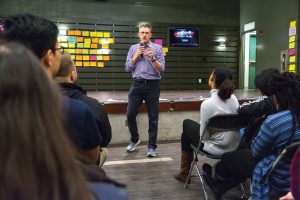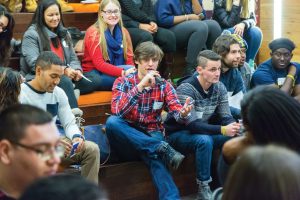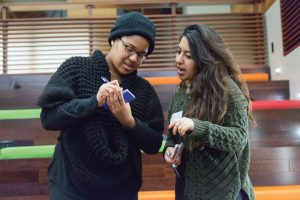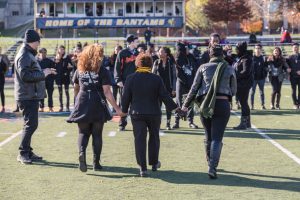 Cultivating a stronger Trinity
Cultivating a stronger Trinity
By Andrew J. Concatelli
If encouraging the development of one student is like planting a tree, and championing the well-being of the student body is like tending to a forest, then strengthening the culture of the College community is like enhancing the ecosystem in which everything grows.
Such is the scope of the student-centered Campaign for Community, a major initiative launched by Trinity College President Joanne Berger-Sweeney in the spring of 2015. The Campaign examines and addresses some of the biggest issues facing any college: academic environment, social environment, diversity and inclusion, community involvement, school pride, sexual misconduct, and drugs and alcohol.
While improving the campus climate will both encourage the growth of each individual student and advance the institution as a whole, a shift in the Trinity ecosystem will not happen instantly: the changes the Campaign is looking to foster — based on recommendations from students themselves — require the participation and commitment of people from every corner of campus.

Joe DiChristina, dean of campus life and vice president for student affairs, speaks to leadership summit attendees.
In less than a year, the Campaign has progressed from big-picture planning to the implementation of specific recommendations. Each of the past two semesters has been preceded by a Student Leadership Summit, as suggested by students to help unify the leaders of social, cultural, and athletic organizations to generate more collaboration and respect across campus. These summits are the first and most visible example of the student recommendations being put into action.
“The students have responded with their time, with ideas, and with a genuine care to bring about change on very specific topics,” says Joe DiChristina, dean of campus life and vice president for student affairs. “I believe this represents a special opportunity, as the Campaign has students involved. Our responsibility as a College is to keep that fire going. We do this by responding to ideas, by being present with students, and by effecting change from within.”
THE ROOTS

Davis United World Scholar Timothy McDermott ’18, with microphone, voices his thoughts at the leadership summit.
With the campuswide conversation she launched within a year of her arrival at Trinity, Berger-Sweeney is encouraging students, faculty, staff, and administrators to ask themselves some difficult questions. What do we value? What can we do better? How can we become the community we wish to be?
A letter to the Trinity community from Berger-Sweeney in April 2015 introduced the Campaign and the motivation behind it, including stories of intolerance and excessive behaviors coupled with disturbing national trends and the responses to several recent student surveys.
From the beginning, the president knew that the Campaign could not offer instant gratification but instead would signal a new era of self-evaluation and collaboration. “Developing a vision of community for a complex academic organization is not an end point but rather an evolution and an ongoing process,” she wrote in the letter. “Realizing a vision of community requires us to be reflective about ourselves, to acknowledge our shortcomings, to take risks, to innovate, and to venture with courage beyond our usual comfort zones.”
Berger-Sweeney asked College Chaplain Allison Read to lead the Campaign and an Administrative Working Group (AWG) comprising staff members, administrators, and a student representative, Kate Dietrich-Manion ’18, who is student life chair for the Student Government Association (SGA). Dietrich-Manion, a Jill G. and Peter S. Kraus Presidential Scholar, says, “I hoped that by representing the student voice on the AWG, I would be able to make certain that students remained the focus of the Campaign, with their priorities at the forefront.”
THE FIRST BUDS
Phase I of the Campaign for Community assembled teams of students — each supported by College faculty and staff advisers — to identify specific means of improving campus climate. Five Student Working Groups (SWGs) met during the fall 2015 semester to pinpoint strategies and to propose programs. Phase I culminated in November 2015 with TrinColl2Action, an event where more than 200 people listened to the SWGs present their recommendations. Berger-Sweeney pledged $25,000 from her Presidential Discretionary Fund to support the implementation of some of the projects, and she challenged the SGA to provide additional funds.

Benjamin Chait ’16, Marjorie Burke ’17, and Tamara Bascome ’17, are among those taking part in an activity during a leadership summit at Vernon Social in January.
The student group focusing on Trinity’s academic environment seeks to create a campus in which individual academic excellence is pursued by all students and is celebrated by the entire community. “There should be some sort of social capital for being a leader academically,” says Michael A. Moraski ’72 Memorial Scholar Ian Robinson ’16. The group recommended the establishment of a Trinity honor society to provide high-achieving students with a network of similarly driven individuals and the establishment of faculty-student dinner parties.
A group addressing community involvement recommended Trinity embracing its presence in Hartford and serving the city through more community service initiatives. Summit Scholar Nicolas Nagle ’17 says, “Trinity and Hartford are two different worlds in terms of culture, but that must be overcome. The best way to do that is to inquire about placing representatives of the institution into the functions of the city while simultaneously inviting the city into the institution and allowing cultures to be shared.” To further embrace all cultures on campus, the group suggested a celebration of Trinity students who come from around the world. The SWG also recommended a conflict-resolution seminar and increased sustainability efforts.
The students focusing on school pride aim to strengthen the unity of Bantams past and present through the emphasis on old traditions and the creation of new ones. “Events like Homecoming could bring together students from all walks of life, allowing all Trinity students to feel as if they are a part of the community,” says Elise Lasky ’17. “Our student working group was inspired by the idea of creating a Bantam identity that current students, alumni, and future students are proud to be associated with.”

Posse Scholar Ainslya Charlton ’16 and Alicia Abbaspour ’18 engage in an activity at the January leadership summit.
Students examining the social environment at Trinity mapped out a vision for a more involved and collaborative student body. The group championed using the Bantam Network’s Nests to help integrate the incoming class with the rest of the students on campus. It also proposed the student leader summits that have been instituted. “The leadership training was one of the most memorable events of the Campaign and of my overall career at Trinity,” says Dietrich-Manion. “The energy in the room was truly remarkable in its positivity. … I left that day with a sense of hope that what we were doing could make a difference and that the community we wish to have is not as far away as one may think.” And thanks to student feedback, an additional student working group addressing drugs and alcohol on campus was created.
The group dedicated to addressing sexual misconduct recommended several steps to improve gender equity, LGBT inclusion, and education on sexual misconduct, including a proposed exploration of the definition of consent in the College’s sexual misconduct policy. Whitney Gulden ’16 says, “By requiring and educating students about affirmative consent, we are teaching generations to ask for verbal consent, which is an essential but underrated skill.” The group also recommended broader communication of sexual assault statistics.
TrinColl2Action was encouraging for many. “The turnout for the event was one of the greatest I have seen at an event like this,” says Maggie A. Elias ’17. “No one was required to be there for a class or other commitment. Everyone simply wanted to see what these groups had to offer in order to better our Trinity community.”
BRANCHING OUT

President Joanne Berger-Sweeney, center, and two students walk hand in hand at a demonstration of solidarity at Homecoming 2015.
Just as the Campaign was beginning to engage the Trinity community in discussions about the campus culture last fall, a larger conversation about diversity and inclusion in higher education was taking place around the country at schools including the University of Missouri and Yale University. Trinity student leaders organized a demonstration of solidarity that took place on the football field during halftime of the Homecoming football game.
Karla Spurlock-Evans, dean of multicultural affairs and senior diversity officer, says, “Early in her tenure, President Berger-Sweeney recognized that Trinity must work to create a sense of community that bridges boundaries of race, culture, class, and gender. The students who sponsored the demonstration at halftime and organized a campuswide forum the following Monday raised issues — in poignant and personal detail — that fully illustrated earlier survey findings that had informed the president’s assessment.
“A number of Trinity students shared painful experiences of alienation and exclusion similar to those expressed by students who protested on other campuses, yet the Trinity student demonstration and speak-out was different from a number of others. Trinity student organizers consciously adopted a spirit of inclusiveness and collaboration — with other students, with faculty and staff, with administrators. Mindful that President Berger-Sweeney had previously recognized the fissures in our community and called for students to help design a plan for change, Trinity student leaders were encouraged to believe that the College would hear their concerns and work to address them. And, indeed, in the days and weeks since the protest, Chaplain Read has made a concerted effort to reach out to the leaders of the student demonstration to solicit their input and to incorporate their recommendations with those made by students working with the Campaign for Community.”
FUTURE GROWTH
The brainstorming in Phase I has given way to the action of Phase II. “In the fall semester, the Campaign for Community created a space for students to connect, for them to identify and give shape to the community that we wish to be,” Read says. “It’s a priority in the spring semester that we cultivate greater awareness of the students’ steps toward creating that community. Phase II is a dynamic process, with each recommendation moving forward on its own timeline.”
All the recommendations presented by the students were included in a report to Berger-Sweeney, who is working with staff to determine which projects should be given top priority. The Administrative Working Group continues to meet weekly to discuss the recommendations’ progress, and subcommittees of students work on how to implement them. The Campaign relies on student engagement at every step of the process. “It is completely in our hands,” says Elias. “We have the opportunity to make a difference and change this special place … for the better.”
Dietrich-Manion adds, “If change is desired, it must come from us, as ultimately we have the power to shape the environment of the entire school. … Although it is a large responsibility, I believe it is one to which Trinity students can and will rise.”
The students working on the Campaign know that not all of its far-reaching goals can be achieved before they graduate and leave campus. Robinson, for one, says that he appreciates the impact of the Campaign on future generations of Bantams.
“I’ve had to understand the idea of planting the trees that you’ll never sit under the shade of,” Robinson says. “This Campaign will be a seed to enhance the social and academic culture of Trinity.”
For more information about the Campaign for Community, please visit http://www.trincoll.edu/AboutTrinity/offices/president/CampaignForCommunity.
See pictures on Flickr.
